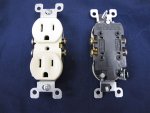I thought we were talking about the code intent for 300.13(B).
That is totally different from the intent of the code sections that you are talking about. In general the intent of those sections is to get away from the common disconnect requirement for MWBCs...not because there is any problem with the use of MWBCs.
The highlighted red is what I am addressing in your post. I am well aware of the common disconnect issue. I stated that in my original post #30, go read it again. What I am getting at is the 'definition' issue from the NEC which is where this thread lead to from the op question of a required pigtail or not of 300.13(B), which would lead you to the intent for those articles as well. I will try to connect the dots here.
GoldDigger said:
Since that part of the circuit is no longer an MWBC (or is both an MWBC and a single branch circuit?) the rule should not apply there.
I would agree there is very little real danger of the loose neutral having voltage at this point, I would have to disagree and say this is still part of the MWBC.
post #8
mwm1752 said:
While I agree with you both, note that the branch circuit extends fully to the wiring path to end of line, and yet the final OCPD defines the branch circuit as multiwire.
Branch Circuit. The circuit conductors between the final overcurrent device protecting the circuit and the outlet(s).
Branch Circuit, Multiwire. A branch circuit that consists of two or more ungrounded conductors that have a voltage between them, and a grounded conductor that has equal voltage between it and each ungrounded conductor of the circuit and that is connected to the neutral or grounded conductor of the system.
post #14 iwire's response to mwm1752
iwire said:
Once the MWBC splits out it no longer fits the defintion you posted.
post #16
iwire said:
There is nothing to argue about.
Once you are down to a 12/2 cable for instance there is only one ungrounded conductor making it outside the definition of a MWBC.
This is one of the reasons for my comment. If we accept this interpretation, then it would have to apply to 2014 NEC 700.19 and 517.18(A) as well which states
517.18(A) ....Branch circuits serviing patient bed locations shall not be part of a multiwire branch circuit
700.19 Multiwire Branch Circuits. The branch circuit serving emergency lighting and power circuits shall not be part of a multiwire branch circuit.
The definition of a MWBC was not modified by those articles, so the original definition still stands. So in the examples I gave concerning a hospital and emergency power in any location, you would have to accept that the end of the line, (ie the outlet) is still part of the mwbc and the rules surrounding mwbc applies.
And also
post #34
iwire said:
The part you are extending from IS a two wire circuit that happens to be supplied from a MWBC. That being the case you can't extend it.
If everyone notice from the section 2014 NEC 700.19 and 517.18(A) the word
'supplied' is not there. It says
'part of'. If one cannot extend that 2 wire portion of the circuit because it is 'part of' the circuit, which according to some is not a mwbc because of the 2 wire, then the same rule applies to other areas as well. All end of line outlets would still be part of the mwbc even with the break away to just 2 wire, not because of a danger of opening the grounding conductor because in theory there is none, but because of the application of the definition of a mwbc.

